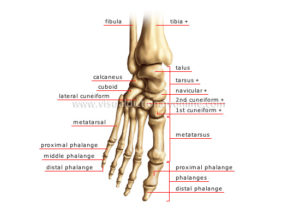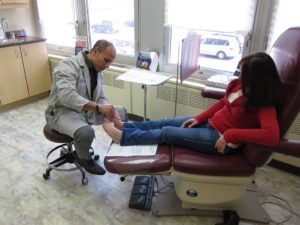Let’s start this week’s topic with a little anatomy lesson. Not like the one in the song above but we’ll look at the anatomy of the foot. As we have talked about before, you have 26 bones in your foot. This is over 25 percent of the bones in your body. Each of the bones in your foot is connected to another bone. This is a good thing because otherwise you would have trouble putting on shoes.
In the middle of your foot, you have your metatarsal bones. Those are the ones that lead to your toes, which have phalange bones. There are three phalange bones in each toe – the proximal, middle, and distal phalange bones. Distal phalange bones are the bones in the tips of your toes.
In between each of these bones there is a joint. Being more specific, there is a synovial joint between each bone in your toes. The synovial joint is surrounded by a thick flexible membrane which forms a sac where the synovial fluid is secreted to lubricate the joint. On the outside of this thick flexible membrane is a ligament. This area is called the joint capsule.
Capsulitis is a condition when the ligament surrounding the joints become inflamed. In your feet, this can happen at the metatarsophalangeal or MTP joint. This is the joint where your metatarsal bone (the long bone in your foot) meets the proximal phalange bone (the first bone in your toe). Capsulitis usually occurs in the second toe although it can happen in the third or fourth toe also.
Capsulitis is uncomfortable. It can feel like you are walking on a pebble. If left untreated, the ligaments can and cause a dislocation of the toe. This is why capsulitis is sometimes called predislocation syndrome. This dislocation will cause your toe to wander over so that it will cross over the toe next to it. (I don’t think this is a look you are looking for…)
If you read this blog on a regular basis, (THANK YOU!) you may have heard other conditions described as having the feel of walking on a pebble. You get a gold star. I have described other conditions – particularly Morton’s neuroma – as feeling like that. You need to go to your friendly local podiatrist to find out what condition you have if you are feeling like you are walking on a pebble. I can’t tell you on this page which one you might have. You need to have the doctor, who is trained to know the difference, look at your foot.
This is the important thing for you to know about capsulitis. If you wait, you will be sorry. Go to the doctor when it first starts to hurt. The best treatment outcomes for capsulitis are found when it is tackled quickly. If you wait too long, you could end up with surgery as your only option. I am sure you are not interested in that being your option. So go to the doctor and get yourself out of pain.
When treated quickly, you and your doctor can go over a range of treatments. Overall, you want to get the joint stable, you want to alleviate the pain, and address the problem so it will be better. You will probably need to rest your foot and use ice. Also over the counter pain/inflammation relieving medicines can be used. The doctor might suggest taping or splinting the toe to the toe next to it to hold it in place. Either the doctor can show you some stretching exercises or you might go to PT to learn exercises to help. It is very possible that using orthotics will help support your foot and help distribute the weight off the injured area.
Please if you don’t remember anything else from this, remember that you need to get to the doctor if you start feeling like you are walking on a pebble.



